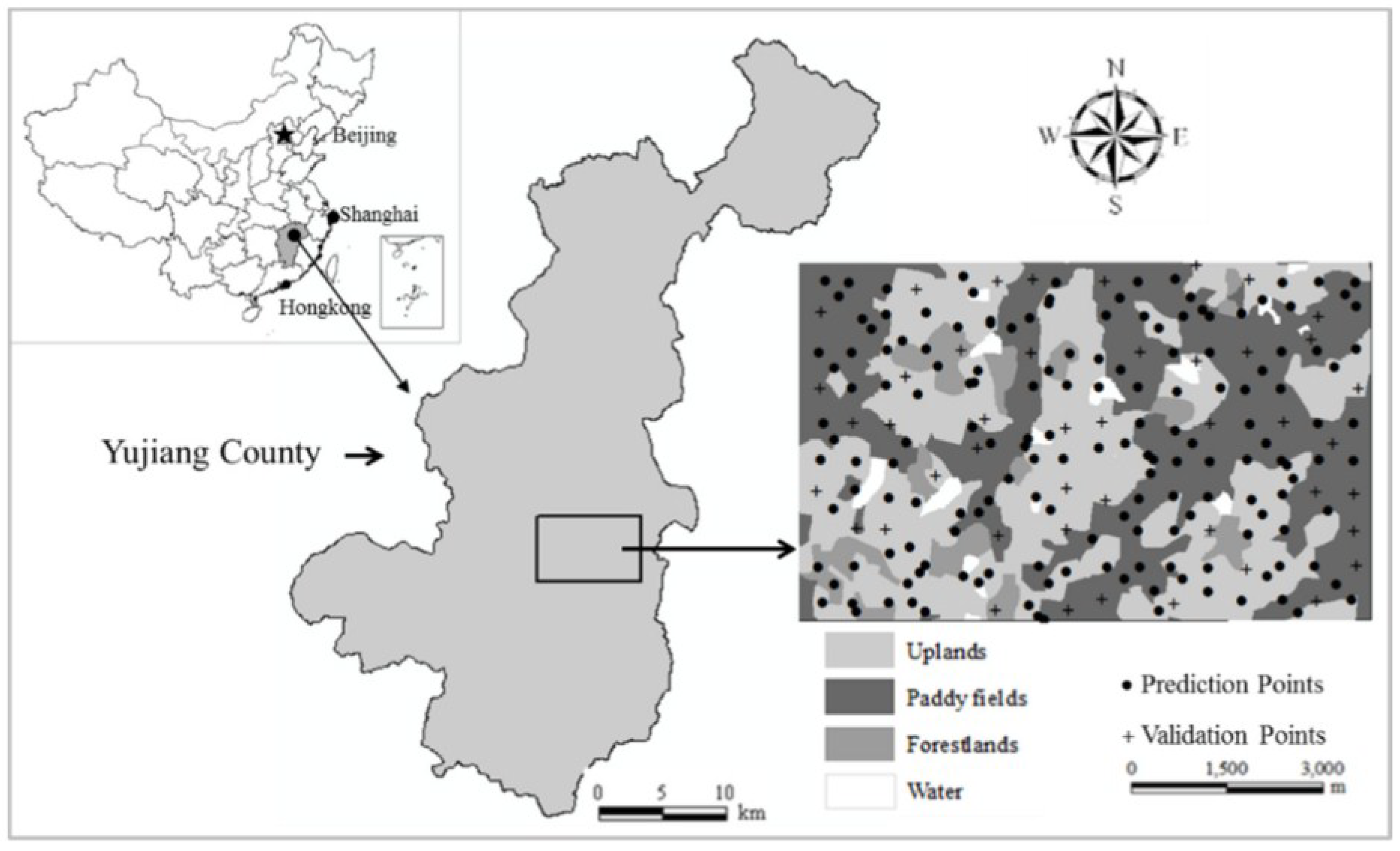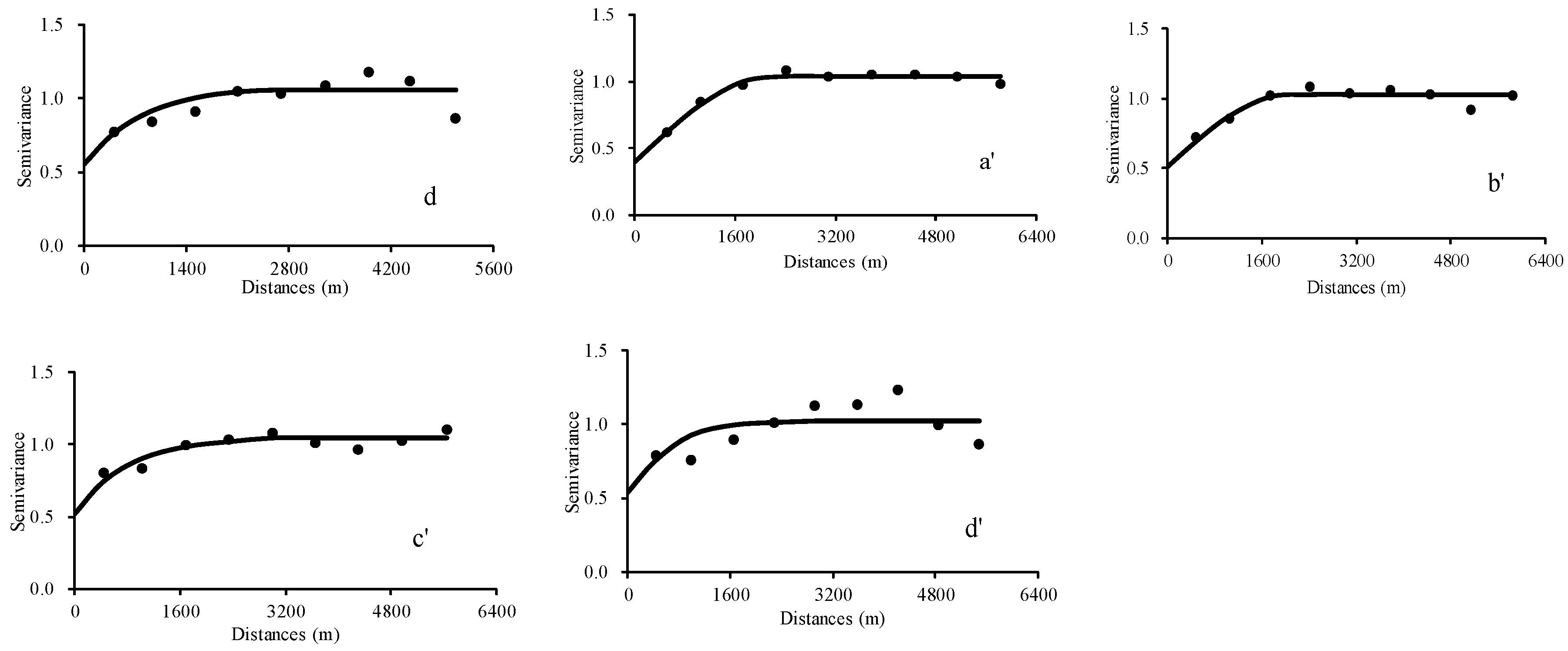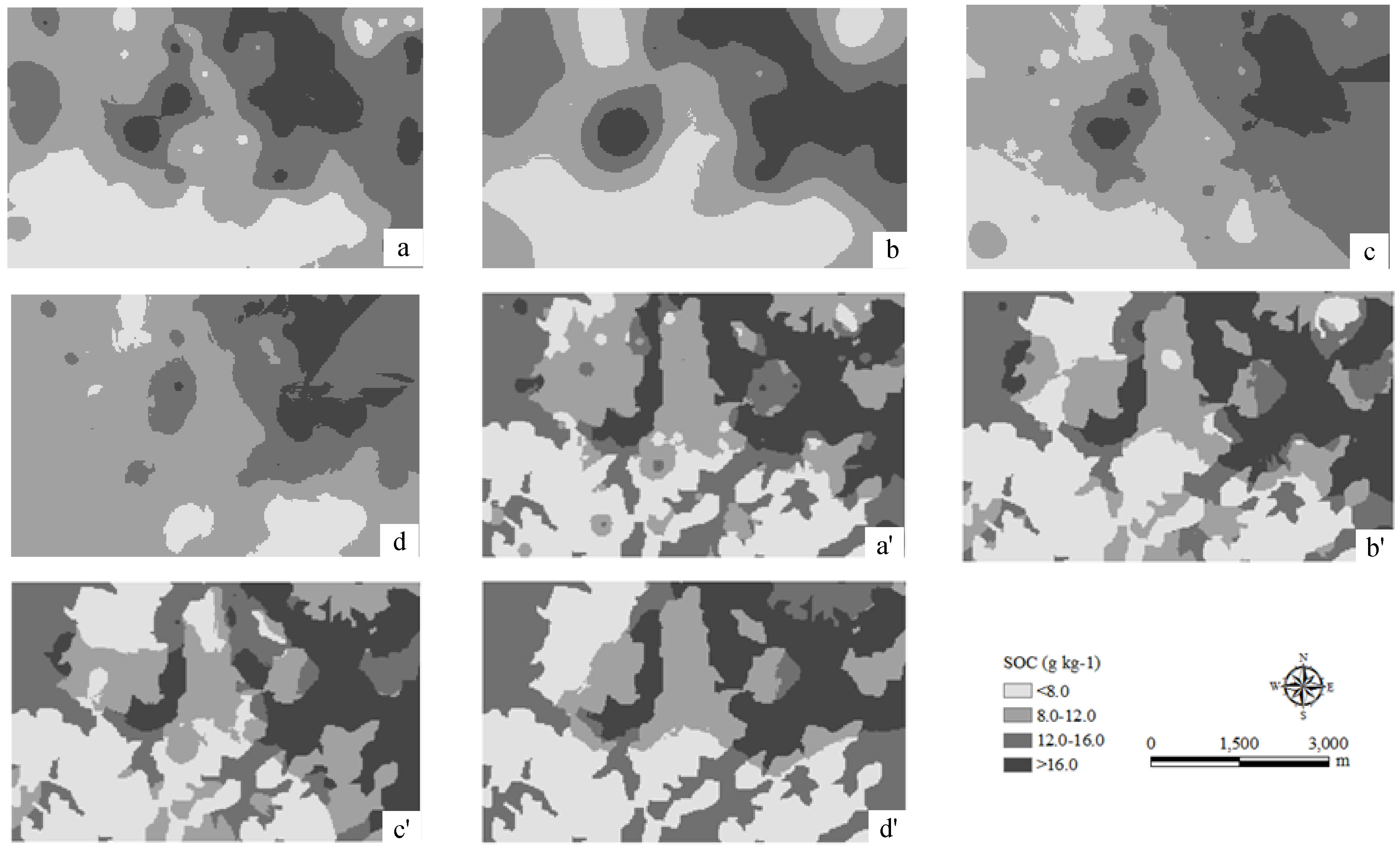Influence of Sampling Point Discretization on the Regional Variability of Soil Organic Carbon in the Red Soil Region, China
Abstract
:1. Introduction
2. Materials and Methods
2.1. Study Area
2.2. Soil Sample Collection and Processing
2.3. Sample Discretization Levels Setting
2.4. Spatial Interpolation Methods
2.5. Uncertainty Evaluation of Spatial Interpolation
3. Results
3.1. Statistical Characteristics of SOC Content
3.2. Geostatistical Analysis of SOC Contents
3.3. Interpolation Contours of SOC Content at the Various Sample Discretization Levels
3.4. Uncertainty Evaluation of Spatial Interpolation at Various Discretization Levels
4. Discussion
5. Conclusions
Author Contributions
Funding
Conflicts of Interest
References
- Lal, R. Soil carbon sequestration to mitigate climate change. Geoderma 2004, 123, 1–22. [Google Scholar] [CrossRef]
- Jones, C.; Mcconnell, C.; Coleman, K.; Cox, P.; Falloon, P.; Jenkinson, D. Global climate change and soil carbon stocks; predictions from two contrasting models for the turnover of organic carbon in soil. Glob. Chang. Biol. 2010, 11, 154–166. [Google Scholar] [CrossRef]
- Wang, S.; Zhuang, Q.; Wang, Q.; Jin, X.; Han, C. Mapping stocks of soil organic carbon and soil total nitrogen in liaoning province of china. Geoderma 2017, 305, 250–263. [Google Scholar] [CrossRef]
- Zeng, H.; Xu, H.; Liu, Z.; Huang, X.; Xiao, S. Variability of soil organic carbon and factors affecting it in residential lands in a rapidly urbanizing area: A case study of nantai island of fuzhou city, china. Acta Ecol. Sin. 2018, 38, 1427–1435. (In Chinese) [Google Scholar] [CrossRef]
- Zhang, H.; Wu, P.; Yin, A.; Yang, X.; Zhang, M.; Gao, C. Prediction of soil organic carbon in an intensively managed reclamation zone of eastern china: A comparison of multiple linear regressions and the random forest model. Sci. Total Environ. 2017, 592, 704–713. [Google Scholar] [CrossRef] [PubMed]
- Hounkpatin, O.; Hipt, F.; Bossa, A.; Welp, G.; Amelung, W. Soil organic carbon stocks and their determining factors in the dano catchment (southwest burkina faso). Catena 2018, 166, 298–309. [Google Scholar] [CrossRef]
- Zhang, Z.; Yu, D.; Shi, X.; Weindorf, D.; Wang, X.; Tan, M. Effect of sampling classification patterns on SOC variability in the red soil region, China. Soil Till. Res. 2010, 110, 2–7. [Google Scholar] [CrossRef]
- Hedley, C.; Payton, I.; Lynn, I.; Carrick, S.; Webb, T.; Mcneill, S. Random sampling of stony and non-stony soils for testing a national soil carbon monitoring system. Soil Res. 2012, 50, 18–29. [Google Scholar] [CrossRef]
- Sankey, J.; Brown, D.; Bernard, M.; Lawrence, R. Comparing local vs. global visible and near-infrared (VisNIR) diffuse reflectance spectroscopy (DRS) calibrations for the prediction of soil clay, organic C and inorganic C. Geoderma 2008, 148, 149–158. [Google Scholar] [CrossRef] [Green Version]
- Jiao, J.; Yang, L.; Wu, J.; Wang, H.; Li, H.; Ellis, E. Land use and soil organic carbon in China’s village landscapes. Pedosphere 2010, 20, 1–14. [Google Scholar] [CrossRef]
- Zhang, S.; Xu, M.; Zhang, Z.; Li, B.; Na, A.; University, F. Methods of Sampling Soil Organic Carbon in Farmlands with Different Landform Types on the Loess Plateau. J. Nat. Resour. 2018, 33, 634–643. (In Chinese) [Google Scholar] [CrossRef]
- Bhatta, K.; Chaudhary, R.; Vetaas, O. A comparison of systematic versus stratified-random sampling design for gradient analyses: A case study in subalpine Himalaya, Nepal. Phytocoenologia 2012, 42, 191–202. [Google Scholar] [CrossRef]
- Liu, D.; Wang, Z.; Zhang, B.; Song, K.; Li, X.; Li, J. Spatial distribution of soil organic carbon and analysis of related factors in croplands of the black soil region, Northe’ast China. Agric. Ecosyst. Environ. 2006, 113, 73–81. [Google Scholar] [CrossRef]
- Huang, B.; Sun, W.; Zhao, Y.; Zhu, J.; Yang, R.; Zou, Z.; Ding, F.; Su, J. Temporal and spatial variability of soil organic matter and total nitrogen in an agricultural ecosystem as affected by farming practices. Geoderma 2007, 139, 336–345. [Google Scholar] [CrossRef]
- Liu, N.; Wang, Y.; Wang, Y.; Zhao, Z.; Zhao, Y. Tree species composition rather than biodiversity impacts forest soil organic carbon of Three Gorges, southwestern China. Nat. Conserv. 2018, 14, 7–24. [Google Scholar] [CrossRef]
- Frogbrook, Z.; Bell, J.; Bradley, R.; Evans, C.; Lark, R.; Reynolds, B.; Smith, P.; Towers, W. Quantifying terrestrial carbon stocks: Examining the spatial variation in two upland areas in the UK and a comparison to mapped estimates of soil carbon. Soil Use Manag. 2009, 25, 320–332. [Google Scholar] [CrossRef]
- Yu, D.; Zhang, Z.; Yang, H.; Shi, X.; Tan, M.; Sun, W.; Wang, H. Effect of sampling density on detecting the temporal evolution of soil organic carbon in hilly red soil region of South China. Pedosphere 2011, 21, 207–213. [Google Scholar] [CrossRef]
- Zhang, Z.; Yu, D.; Wang, X.; Pan, Y.; Zhang, G.; Shi, X. Influence of the Selection of Interpolation Method on Revealing Soil Organic Carbon Variability in the Red Soil Region, China. Sustainability 2018, 10, 2290. [Google Scholar] [CrossRef]
- Zhao, Y.; Shi, X.; Weindorf, D.; Yu, D.; Sun, W.; Wang, H. Map scale effects on soil organic carbon stock estimation in North China. Soil Sci. Soc. Am. J. 2006, 70, 1377–1386. [Google Scholar] [CrossRef]
- Kumar, S.; Lal, R.; Liu, D. A geographically weighted regression kriging approach for mapping soil organic carbon stock. Geoderma 2012, 189–190, 627–634. [Google Scholar] [CrossRef]
- Kerry, R.; Goovaerts, P.; Rawlins, B.; Marchant, B. Disaggregation of legacy soil data using area to point kriging for mapping soil organic carbon at the regional scale. Geoderma 2012, 170, 347–358. [Google Scholar] [CrossRef] [PubMed] [Green Version]
- Wang, S.; Zhuang, Q.; Jia, S.; Jin, X.; Wang, Q. Spatial variations of soil organic carbon stocks in a coastal hilly area of China. Geoderma 2018, 314, 8–19. [Google Scholar] [CrossRef]
- Dai, W.; Zhao, K.; Fu, W.; Jiang, P.; Li, Y.; Zhang, C.; Gielen, G.; Gong, X.; Li, Y.; Wang, H.; et al. Spatial variation of organic carbon density in topsoils of a typical subtropical forest, southeastern China. Catena 2018, 167, 181–189. [Google Scholar] [CrossRef]
- Chai, X.; Shen, C.; Yuan, X.; Huang, Y. Spatial prediction of soil organic matter in the presence of different external trends with REML-EBLUP. Geoderma 2008, 148, 159–166. [Google Scholar] [CrossRef]
- Liu, T.; Juang, K.; Lee, D. Interpolating soil properties using kriging combined with categorical information of soil maps. Soil Sci. Soc. Am. J. 2006, 70, 1200–1209. [Google Scholar] [CrossRef]
- Kumar, N.; Velmurugan, A.; Hamm, N.; Dadhwal, V. Geospatial Mapping of Soil Organic Carbon Using Regression Kriging and Remote Sensing. J. Indian Soc. Remote 2018, 3, 1–12. [Google Scholar] [CrossRef]
- Wang, J.; Liao, Y.; Liu, X. Course of Spatial Data Analysis, 1st ed.; Science and Technology Press: Beijing, China, 2010; pp. 74–75. ISBN 978-7-03-026605-7. [Google Scholar]
- IUSS Working Group WRB. World Reference Base for Soil Resources 2006; World Soil Resources Reports No. 103; UN Food and Agriculture Organization: Rome, Italy, 2006; pp. 71–72. [Google Scholar]
- Soil Survey Office of Yujiang County. Soil Species of Yujiang County; Science and Technology Press: Beijing, China, 1986.
- Zhang, Z.; Yu, D.; Shi, X.; Wang, N.; Zhang, G. Priority selection rating of sampling density and interpolation method for detecting the spatial variability of soil organic carbon in China. Environ. Earth Sci. 2015, 73, 2287–2297. [Google Scholar] [CrossRef]
- Nelson, D.W.; Sommers, L.E. Total carbon, organic carbon, and organic matter. In Methods of Soil Analysis, Part2-Chemical and Microbiological Properties; Page, A.L., Miller, R.H., Keeney, D.R., Eds.; ASA-SSSA: Madison, WI, USA, 1982; pp. 539–594. [Google Scholar]
- Wong, D.W.S.; Lee, J. Statistical Analysis of Geographic Information with ArcView GIS and ArcGIS; Wiley: Hoboken, NJ, USA, 2005; pp. 218–279. [Google Scholar]
- Zhang, Z.; Shi, X.; Yu, D.; Weindorf, D.; Sun, W.; Wang, H.; Zhao, Y. Effect of prediction methods on detecting the temporal evolution of soil organic carbon in hilly red soil region of South China. Environ. Earth Sci. 2011, 64, 319–328. [Google Scholar] [CrossRef]
- Chaplot, V.; Bouahom, B.; Valentin, C. Soil organic carbon stocks in Laos: Spatial variations and controlling factors. Glob. Chang. Biol. 2010, 16, 1380–1393. [Google Scholar] [CrossRef]
- Qiu, J.; Wang, L.; Li, H.; Tang, H.; Li, C.; Ranst, E. Modeling the Impacts of soil organic carbon content of croplands on crop yields in China. Agric. Sci. China 2009, 8, 464–471. [Google Scholar] [CrossRef]
- Emery, X. Uncertainty modeling and spatial prediction by multi-gaussian kriging: Accounting for an unknown mean value. Comput. Geosci. 2008, 34, 1431–1442. [Google Scholar] [CrossRef]
- Cochran, W.G. Sampling Techniques; John Wiley & Sons: Hoboken, NJ, USA, 2007. [Google Scholar]
- Kerry, R.; Oliver, M. Determining nugget: Sill ratios of standardized variograms from aerial photographs to krige sparse soil data. Precis. Agric. 2008, 9, 33–56. [Google Scholar] [CrossRef]







| Land Use | Sample Size | Minimum | Maximum | Mean † | SD | CV |
|---|---|---|---|---|---|---|
| g kg−1 | ||||||
| Paddy fields | 80 | 2.66 | 24.15 | 15.05a | 5.02 | 33% |
| Dry land | 75 | 2.23 | 21.66 | 7.95b | 5.11 | 64% |
| Forestland | 11 | 3.72 | 14.95 | 8.20b | 2.85 | 35% |
| Total | 166 | 2.23 | 24.15 | 11.39 | 6.06 | 53% |
| Discretization | VMR † | Minimum | Maximum | Mean ‡ | SD | CV |
|---|---|---|---|---|---|---|
| g kg−1 | ||||||
| V1 | 0.12 | 2.66 | 24.15 | 11.11a | 6.21 | 56% |
| V2 | 0.80 | 2.66 | 24.15 | 11.56a | 6.37 | 55% |
| V3 | 1.46 | 2.23 | 24.15 | 10.88a | 6.06 | 56% |
| V4 | 2.17 | 2.23 | 22.24 | 11.46a | 6.09 | 53% |
| Method | Discretization | Distribution | Model | C0 | Sill | C/Sill | Range (m) | R2 |
|---|---|---|---|---|---|---|---|---|
| Ordinary Kriging (OK) | v1 | Normal | Exponential | 0.28 | 1.10 | 0.74 | 3480 | 0.94 |
| v2 | Normal | Spherical | 0.31 | 1.06 | 0.71 | 2190 | 0.82 | |
| v3 | Normal | Exponential | 0.54 | 1.09 | 0.50 | 3870 | 0.75 | |
| v4 | Normal | Exponential | 0.56 | 1.06 | 0.47 | 2430 | 0.58 | |
| Kriging with land use information (LuK) | v1 | Normal | Spherical | 0.40 | 1.04 | 0.62 | 2170 | 0.96 |
| v2 | Normal | Spherical | 0.51 | 1.03 | 0.50 | 2030 | 0.88 | |
| v3 | Normal | Exponential | 0.52 | 1.05 | 0.50 | 2340 | 0.79 | |
| v4 | Normal | Exponential | 0.54 | 1.02 | 0.47 | 1830 | 0.42 |
© 2018 by the authors. Licensee MDPI, Basel, Switzerland. This article is an open access article distributed under the terms and conditions of the Creative Commons Attribution (CC BY) license (http://creativecommons.org/licenses/by/4.0/).
Share and Cite
Zhang, Z.; Sun, Y.; Yu, D.; Mao, P.; Xu, L. Influence of Sampling Point Discretization on the Regional Variability of Soil Organic Carbon in the Red Soil Region, China. Sustainability 2018, 10, 3603. https://doi.org/10.3390/su10103603
Zhang Z, Sun Y, Yu D, Mao P, Xu L. Influence of Sampling Point Discretization on the Regional Variability of Soil Organic Carbon in the Red Soil Region, China. Sustainability. 2018; 10(10):3603. https://doi.org/10.3390/su10103603
Chicago/Turabian StyleZhang, Zhongqi, Yiquan Sun, Dongsheng Yu, Peng Mao, and Li Xu. 2018. "Influence of Sampling Point Discretization on the Regional Variability of Soil Organic Carbon in the Red Soil Region, China" Sustainability 10, no. 10: 3603. https://doi.org/10.3390/su10103603





